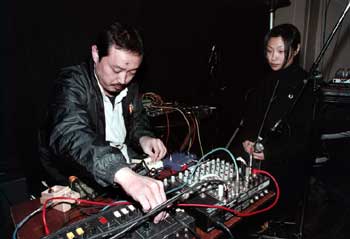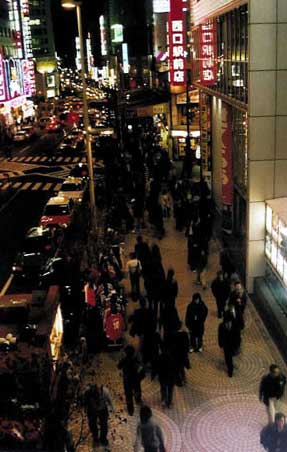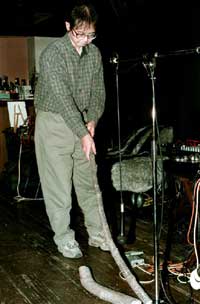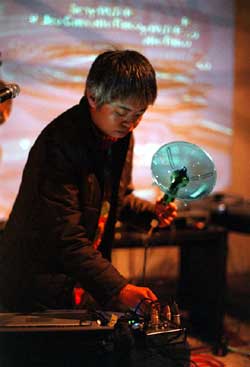What
is Japanese noise music? Mattias Huss
went to Japan to find out and wrote
a tedious thesis about it. Here, on
the other hand, is a quick fix of
select impressions from the land of
rising noise.

Koji
Tano of M.S.B.R. with assistant rustling
dry leaves by a microphone during
this autumnal show.
Photo
by: Martin Ekelin
The
ideology of noise
The Sixth Bowels of Noise Festival
(December 13-14, 2003), hiding among
the love hotels in the heart of Shibuya,
Tokyo, would be nigh impossible to
find without the guiding roar issuing
from the building. Here Japanese and
American noise bands clash during
two days, and two cultures along with
them.
American bands Slogun, Control, Richard
Ramirez etc, radiate danger and provocation.
Thoroughly pierced and muscular, they
cling to the political/sexual/provocative
tradition of early industrial and
noise movement. Although Japanese
noise superstar Merzbow could be blamed
for the proliferation of bondage and
porn imagery in the noise genre, Japanese
artists seem to a great degree uninterested
with this ideological burden of noise
music. M.S.B.R.'s Koji Tano is another
of those benign and quiet noise engineers
approaching middle age, who are doing
SOUND, period.
– This is beautiful music for
me, Koji Tano says, referring to his
own mix of pummelling earth quake
bass, roaring motors and high pitched
squeals. There are no specific messages
in it. I just love sounds.

A
temple of noise. Koji Tano's own (vegetable?)
shop with his office at the back.
Photo by: Mattias Huss
The lure of noise
I loved Japanese noise music before
I even heard it. In fact, I probably
liked it much more back then, as an
idea. This was the intelligent person’s
black metal, I reasoned, unendurable
to any ”ordinary” person,
yet somehow highbrow and mysterious
rather than forcedly ”evil”
and handily linked with the old school
industrial scene, which was my territory
anyway. According to the magazines,
there was this bookish guy named Akita
who didn’t talk much, but who
would come out on stage and make,
like, the MOST EXTREME MUSIC IN THE
WORLD. I don’t know what personal
issues I might have had at the time,
but that really appealed to me.
The
corruption of noise
If you want to be a star, you go to
Tokyo. Osaka, on the other hand, serves
as the DIY garage of Japan. Nearby
Kyoto with its then vibrant university
life could probably lay the claim
to be the origin of Japanese noise
music in the seventies, but noisicians
with strong ties to the sprawling,
industrial giant that is Osaka are
numerous. The arguably most important
japanoise label Alchemy Records keeps
its shop there, with noise music’s
finest screamer Masonna as store clerk.
The Bears club, run by former Boredoms
member Seiichi Yamamoto, and other
strange and tiny venues like Bar Noise
saw the early steps of Japanese noise
terror.
– In the beginning no one was
planning anything, Matt Kaufmann remembers,
introducing me to another closet-sized
music pub in Osaka’s Amerika-mura,
a few blocks of second hand clothing
stores, youth street fashion chaos
and record shops. It was like people
were just crazy. They had no image,
no plan. Visits by big indie artists
from abroad were rare at the time,
so when they came everyone went to
see them. There would always be some
Japanese artist warming up, and people
like Masonna or the Boredoms would
just kick the asses of the main performers.
Yamantaka Eye (Boredoms) was remarkable;
he completely turned the way people
thought about music upside down.
Matt Kaufmann has lived in Osaka teaching
English for around 15 years and covered
the scene in fanzines and magazines.
Many agree with his opinion that noise
music grew stale toward the end of
the nineties, when noise bands started
trying to sound like other noise bands,
pursuing stardom (to the extent that
such is possible in this genre) and
generally sacrificing creativity for
easy bucks.

The shopping
and nightlife district Shinjuku in
Tokyo where Tano's ahop is located.
Photo by: Mattias Huss
The
noise boom
Japanese record labels do not promote
Japanese music abroad, or if they
do, they do it badly. The ”Sukiyaki”
song by Kyu Sakamoto topped the billboard
chart in 1963. Since then, Japan has
not made much of an impression in
the mainstream, despite meagre attempts
at marketing female j-pop stars like
Seiko Matsuda and currently Hikaru
Utada in the US.
The Japanese underground, on the other
hand, tends to find its way out by
other channels. Some promotional groundwork
for the sudden burst of japanoise
upon the world was made by musicians
like John Zorn, who fell in love with
Japanese avant garde and started
releasing their music on his own label,
and Sonic Youth’s Thurston Moore
who even managed to get a snippet
of Masonna played on MTV. All the
while, a network of dedicated micro
labels around the world made their
best trying to package and release
the maelstrom of material flowing
to them from prolific artists such
as Incapacitants, Hijokaidan, Merzbow
and Aube.
–
There was a kind of noise boom between
1992-1996, Yoshiyuki Hiroshige says.
The leader of legendary noise outfit
Hijokaidan and owner of Alchemy Records,
he saw the sales figures for obscure
noise bands suddenly rise, only to
abruptly fall again when the curiosity
generated mainly in America ran out.

Former
Merzbow-member Kiyoshi Mizutani likes
using natural found sounds. Or should
that be golf?
Photo
by: Martin Ekelin
During this time, the imagery of japanoise,
similar to that prevalent in the power
electronics scene overseas in its
depiction of deviant sexuality, war
and so on, became established thanks
to fanzines, posters and record labels
eagerly promoting the extreme nature
of noise with fitting motifs. This
obscured the fact that a large chunk
of the Japanese noise performers took
their inspiration mainly from psychedelic
music and progressive rock, and cared
little for industrial fringe ideology.
– We just loved the live euphoria
of bands like Deep Purple, Black Sabbath
and Jimi Hendrix, Hiroshige remembers,
trying to explain how the group found
their sound. They would really let
go on stage with massive walls of
feedback and things like that.
What Hijokaidan did was dispensing
with melodies, guitar solos and other
boring staples of the rock giants
and cutting straight to the feedback
and orgasmic release of noise from
broken speakers. They may have been
playing guitars, but to all appearances,
it sounded more like the end of the
world as we know it.

Yuko
Kitamura, or Yuko Nexus6 with her
sound gun is part of the new experimental
electronica movement sometimes called
onkyo.
Photo
by: Martin Ekelin
The
sound of noise
Layers upon layers of simultaneous
sound create a ”pure”,
almost anonymous noise. The sound
simply is, without rhythms, temporal
shifts or any kind of distinguishable
patterns. Yet, even this seemingly
stable wall of noise changes irregularly.
There seems to be no peace here, only
a kind of absolute evolving chaos.
Still, noise can be good or bad to
the individual listener. A good noise
performance will open up with patience,
revealing new dimensions and layers
of significance where you first could
hear nothing but a wall of static.
There is nothing Japanese about it.
In its purest form, noise music all
around the world can be described
like that. With globalisation, a Japanese
style can no longer be discerned,
if that indeed ever was the case.
At its core, what fascinated me most
about japanoise was the concept of
noise music seemingly without a message
or an ideology and the zen-like implications
of that. Wasn’t it actually
a spiritual thing, or maybe an expression
of repressed sexuality, or even a
political protest? It took me a B.A.
thesis to realize that sometimes,
you do that kind of thing just for
the hell of it. It’s fun, plain
and simple.
P.S.
These
days many of the grand old men of
japanoise are softening, moving into
ambient territory, switching from
analogue to digital equipment. Quiet
and introspective experimental electronica,
represented by the onkyo scene, is
bubbling vitally in Japan and around
the world. Oh, and more women are
making noise, globally. Japanoise
is not dead; it’s just changing,
interbreeding with the fertile Japanese
electronic underground and producing
quite remarkable offspring in very
different genres. |